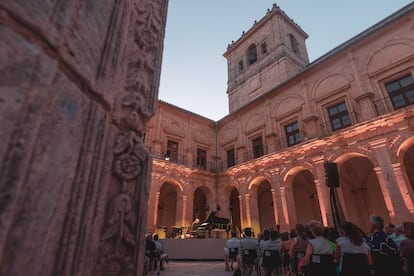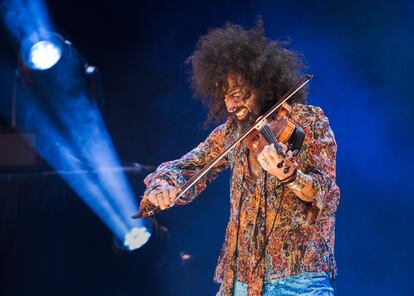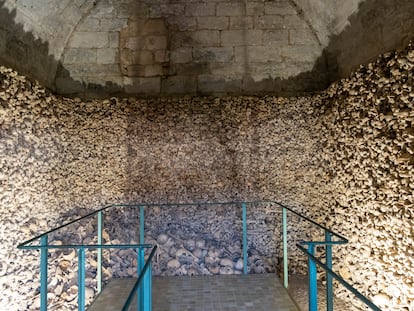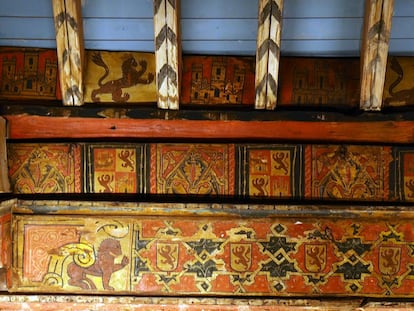Ara Malikian’s violin feels comfortable in the eclectic monastery of Uclés
The Lebanese-born musician brings his fusion of styles to a new international music festival being held in a historic space in Spain

The monastery of Uclés, halfway between Cuenca and Madrid, is a compendium of all the civilizations and aesthetic currents that have come and gone in Spain. The building was conceived as a Muslim fortress to defend Al-Andalus — the part of the Iberian Peninsula under Muslim rule — from the Christian kingdoms in the Middle Ages. It later became the headquarters of the Order of Santiago during the Reconquista, when those kingdoms fought to win back territory from the Umayyad dynasty.
Besides its Arab, Roman and Visigothic vestiges, the monastery also features architectural styles that came much later, including Plateresque, Herrerian and Churrigueresque elements. “The list of the architects of Uclés reads like a history of Spanish architecture,” wrote George Kubler in Architecture of the 17th and 18th Centuries. This highly eclectic ensemble is an ideal setting for a violin concert by Ara Malikian, whose own style blends European orthodoxy with flamenco and oriental rhythms.
Malikian, 55, is slated to play at the monastery on Friday as part of the 1st Uclés Music Festival, which opened on July 14 and brought other world-famous musicians such as Ludovico Eunadi to this ancient location that was once home to Celtiberian, Roman, Muslim and Christian cultures.
The Lebanese-born musician, who has lived in Spain for more than 20 years, included Uclés as a stop in The Ara Malikian World Tour. With more than 40 albums to his name, Malikian’s compositions flow somewhere between classical and oriental music, with touches of tango, flamenco and pop that create a hybrid style that defines him. “One moment he is paying tribute to traditional Jewish music [Pisando flores] and the next he is dedicating Bourj Hammoud to the Armenian neighborhood where he grew up,” wrote Fernando Neira, a music critic for EL PAÍS, about one of his performances at Spain’s Royal Palace in 2020.
Malikian’s eclectic style goes hand in hand with the heterogeneous nature of the architectural complex known as the monastery of Uclés. David Pérez, director of the Fernando Núñez Foundation, the institution that manages the structure’s heritage, argues that this blend of styles is due to the fact that it was on the border of Al-Andalus. “On the outskirts of the monastery there was an Almoravid village [a religious and political movement with a more rigorous interpretation of Islam] that is now being excavated.” As evidence of the Muslim past in the architectural complex of Uclés, Pérez highlights a 200-meter-long section of wall from the times of the Muslim fortress as well as an Albarrana tower, a defensive structure built by the Muslims in the peninsula in the Middle Ages.

The Roman touch is evident in some incisions on the Plateresque façades of the monastery, while the Visigothic influence can be traced to a stone located in the stables and used as an ornament. Just as multiculturalism permeates the architecture of Uclés, so does it define Malikian’s music and career. The violinist lived as a nomad for much of his life. At the age of 14 he had to leave Beirut due to the Lebanese civil war. The following year he received a scholarship to study music in Germany, then he lived in England and France for a while before finally settling down in Spain at the end of 1998.
The long journey took him further and further away from his academic and classical training, but it has not disappeared altogether from his fusion sounds. “Today what I do is for the public, it is neither for the programmers nor for the managers,” he said in an interview with EL PAÍS in 2015. “It is for the audience, which does not ask for perfection nor to hear a composition exactly as it was played 300 years ago. The audience wants to be moved.”
His goal will be put to the test inside the monastery’s Baroque-style courtyard, created in the first half of the 18th century, during the reign of Philip V, in what represented the final phase of construction that followed the Renaissance stage in the 16th century.
This unique blend of history, architecture and music will come together on Friday at a concert that is attracting 1,200 people to a village with a population of 200.
Sign up for our weekly newsletter to get more English-language news coverage from EL PAÍS USA Edition
Tu suscripción se está usando en otro dispositivo
¿Quieres añadir otro usuario a tu suscripción?
Si continúas leyendo en este dispositivo, no se podrá leer en el otro.
FlechaTu suscripción se está usando en otro dispositivo y solo puedes acceder a EL PAÍS desde un dispositivo a la vez.
Si quieres compartir tu cuenta, cambia tu suscripción a la modalidad Premium, así podrás añadir otro usuario. Cada uno accederá con su propia cuenta de email, lo que os permitirá personalizar vuestra experiencia en EL PAÍS.
¿Tienes una suscripción de empresa? Accede aquí para contratar más cuentas.
En el caso de no saber quién está usando tu cuenta, te recomendamos cambiar tu contraseña aquí.
Si decides continuar compartiendo tu cuenta, este mensaje se mostrará en tu dispositivo y en el de la otra persona que está usando tu cuenta de forma indefinida, afectando a tu experiencia de lectura. Puedes consultar aquí los términos y condiciones de la suscripción digital.
More information
Archived In
Últimas noticias
New York enters the era of Zohran Mamdani
Welcome to the post-religion era: The idea of Christianity as the absolute truth has become obsolete
‘I thought you would like it’: The risky sexual practice popularized by TV shows and TikTok
The digitalization of tourism: ‘They promise experiences and gave us the worst possible one’
Most viewed
- Sinaloa Cartel war is taking its toll on Los Chapitos
- Reinhard Genzel, Nobel laureate in physics: ‘One-minute videos will never give you the truth’
- Oona Chaplin: ‘I told James Cameron that I was living in a treehouse and starting a permaculture project with a friend’
- Why the price of coffee has skyrocketed: from Brazilian plantations to specialty coffee houses
- Silver prices are going crazy: This is what’s fueling the rally










































